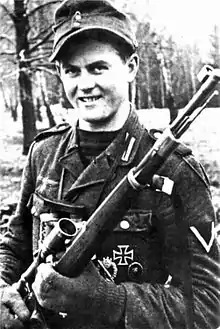Matthäus Hetzenauer
Matthäus Hetzenauer (23 December 1924 – 3 October 2004) was an Austrian sniper in the Wehrmacht of Nazi Germany during World War II. He served in the 3rd Mountain Division on the Eastern Front of World War II, and was credited with 345 kills. His longest confirmed kill was reported at 1,100 meters (1,200 yards).[1] Hetzenauer received the Knight's Cross of the Iron Cross on 17 April 1945.[2]
Matthäus Hetzenauer | |
|---|---|
 Matthäus Hetzenauer with a Kar98k sniper variant | |
| Born | 23 December 1924 Brixen im Thale, Austria |
| Died | 3 October 2004 (aged 79) Brixen im Thale, Austria |
| Allegiance | |
| Service/ | Heer |
| Years of service | 1943–1945 |
| Rank | Gefreiter |
| Unit | 3rd Mountain Division |
| Battles/wars | World War II |
| Awards | Knight's Cross of the Iron Cross |
Early life

Matthäus Hetzenauer was born on 23 December 1924 in the Austrian Tyrolean village of Brixen im Thale to Simon and Magdalena Hetzenauer, descendants of a long line of Austrian peasantry in the Kitzbühel region. He was baptized as a Catholic on Christmas Eve in the medieval parish church and was raised with his two brothers and sister on his parents’ farm above the village.[lower-alpha 1] Hetzenauer grew up surrounded by the long Tyrolen custom of hunting and hunters, such as the tale of Georg Jennerwein, his father was a hunter, and his uncle Josef was a veteran of the Austro-Hungarian Army who displayed his medals, including an Iron Cross, in a display case. With this backdrop, Hetzenauer was drafted in September 1942 at age 17 into the 140th Mountain Rifle Reinforcement Battalion based at Kufstein.[4]
Military career
Hetzenauer arrived at Kufstein in 1942 and trained for two years as a Gebirgsjäger in the city and in the nearby Wilder Kaiser mountains, which his upbringing in the Tyrol had conditioned him for, then he received further instruction at the Gebirgsjäger school in Mittenwald, Hochgebirgsjäger school in the Stubaital, and the Army NCO Gebirgsjäger school in Wörgl.[5] Hetzenauer then trained as a sniper during March - July 1944 at the Truppenübungsplatz Seetaler-Alpe in Steiermark, before being assigned as a Gefreiter to the 3rd Gebirgsjäger Division. He utilized both a Karabiner 98k sniper variant with 6x telescopic sight and a Gewehr 43 with ZF4 4x telescopic sight.[6] He saw action against Soviet forces in the Carpathians, Hungary, and Slovakia.
On 6 November 1944 he suffered head trauma from artillery fire, and was awarded the Wound Badge three days later.
Gefreiter Hetzenauer received the Knight's Cross of the Iron Cross on 17 April 1945. Generalleutnant and Divisions commander Paul Klatt had recommended Hetzenauer because of his numerous sniper kills, which totalled two enemy companies, without fear for his own safety under artillery fire and enemy attacks. This recommendation was approved by General der Gebirgstruppe Karl von Le Suire and General der Panzertruppe Walter Nehring.[7]
Hetzenauer was captured by Soviet troops the following month, and served five years in a Soviet prison camp.
He died on 3 October 2004. His wife Maria died in 2006.[8]
Awards
- Iron Cross (1939) 2nd Class (1 September 1944) & 1st Class (25 November 1944)[9]
- Wound Badge (1939) in Black (9 November 1944)[9]
- Infantry Assault Badge in Silver (13 November 1944)[9]
- Sniper's Badge in Gold (3 December 1944; one of three recipients)[9]
- Knight's Cross of the Iron Cross on 17 April 1945 as Gefreiter and sniper in the 7./Gebirgsjäger-Regiment 144[10][2]
Notes
Citations
- Sadowski 2015, Chapter 3: A Brief History of Military Snipers.
- Scherzer 2007, p. 388.
- "Sonnleithof". kitzbueheler-alpen.com/en. Kitzbühler Alpen. Retrieved 10 May 2018.
- Kaltenegger 2017, p. 3, 6, 7-8, 17-21.
- Kaltenegger 2017, pp. 22, 24-25.
- Sadowski 2015, chptr 3 A Brief History of Military Snipers.
- Thomas & Wegmann 1993, p. 306.
- https://ww2gravestone.com/people/hetzenauer-matthaus/
- Thomas & Wegmann 1993, p. 307.
- Fellgiebel 2000, p. 225.
References
English
- Kaltenegger, Roland (2017). Eastern Front Sniper: The Life of Matthäus Hetzenauer. Greenhill Books. ISBN 1784382183.
- Sadowski, Robert A. (2015). Shooter's Bible Guide to Tactical Firearms: A Comprehensive Guide to Precision Rifles and Long-Range Shooting Gear. Skyhorse Publishing. ISBN 978-1-63220-935-1.
German
- Fellgiebel, Walther-Peer (2000) [1986]. Die Träger des Ritterkreuzes des Eisernen Kreuzes 1939–1945 — Die Inhaber der höchsten Auszeichnung des Zweiten Weltkrieges aller Wehrmachtteile (in German). Podzun-Pallas. ISBN 978-3-7909-0284-6.
- Scherzer, Veit (2007). Die Ritterkreuzträger 1939–1945 Die Inhaber des Ritterkreuzes des Eisernen Kreuzes 1939 von Heer, Luftwaffe, Kriegsmarine, Waffen-SS, Volkssturm sowie mit Deutschland verbündeter Streitkräfte nach den Unterlagen des Bundesarchives (in German). Scherzers Miltaer-Verlag. ISBN 978-3-938845-17-2.
- Thomas, Franz; Wegmann, Günter (1993). Die Ritterkreuzträger der Deutschen Wehrmacht 1939–1945 Teil VI: Die Gebirgstruppe Band 1: A–K (in German). Biblio-Verlag. ISBN 978-3-7648-2430-3.